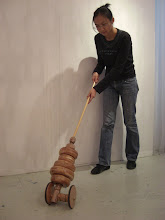ii. Art theory (on objective sculptures: mostly statues of human figures)
1.For what purpose was this object made? (represent a deity? A human being as a deity? )
2.Portrait? (If so à accessories? A strong sense of an individual? )
3.Pose
4.drapery
5.Medium, techniques
6.Size
7.What kind of volume? (Geometric? Irregular?)
8.What’s the original site? (public square? Pediment?)
9.Is the base part of the work?
10.Where is the best place to stand in order to experience the work?
--------------------
ii. Art theory (on objective sculptures)
1.For what purpose was this object made?
What does the highly ordered, symmetrical form of the King suggest about the man?

Egyptian, King chefren, ca. 2500BC. 5’6”
now at Egyptian Museum, Cairo
What does the highly ordered, symmetrical form of the King suggest about the man?


Egyptian, King chefren, ca. 2500BC. 5’6”
now at Egyptian Museum, Cairo
ii. Art theory (on objective sculptures)
2. Portrait?
-A strong sense of an individual? Or just of a type?
-In the tradition of idealizing, commemorative images of elders usually show them in the prime of life.


2. Portrait?
-A strong sense of an individual? Or just of a type?
-In the tradition of idealizing, commemorative images of elders usually show them in the prime of life.


ii. Art theory (on objective sculptures)
-3. Pose: what does the pose imply? Effort? Rest? Arrested motion? Authority?
-Are certain bodily features or forms distorted? Why?
-3. Pose: what does the pose imply? Effort? Rest? Arrested motion? Authority?
-Are certain bodily features or forms distorted? Why?


•Jefferson Memorial: standing, one foot slightly advanced, fainly smiling faceàsuggest confidence & action
ii. Art theory (on objective sculptures)
4.drapery:
•is it independent of the body?
•Does it express or diminish the volumes (enclosed space e.g. knees, breasts) that it covers?
•Does it indicate bodily motion or an independent harmony?
4.drapery:
•is it independent of the body?
•Does it express or diminish the volumes (enclosed space e.g. knees, breasts) that it covers?
•Does it indicate bodily motion or an independent harmony?
e.g. welded iron suggested heavy industry, in contrast with bronze and marble, which suggested nobility
e.g. Rodin’s walking man: bulit up by modeling clay and then cast in bronzeà recalls in every square inch of the light-catching surface a sense of the energy that’s expressed by the figure
e.g. King Chefren: cut away from the block that did not look like him: solidity of stone


e.g. Rodin’s walking man: bulit up by modeling clay and then cast in bronzeà recalls in every square inch of the light-catching surface a sense of the energy that’s expressed by the figure
e.g. King Chefren: cut away from the block that did not look like him: solidity of stone


ii. Art theory (on objective sculptures)
Size: larger than life à suggest?

ii. Art theory (on objective sculptures)
7. Geometric? Irregular?
King Chefren has a closed formà
stability and permanence

Mercury has an open form
 “Mercury” (1580) 69” By Giovanni da Bologna
“Mercury” (1580) 69” By Giovanni da Bologna
ii. Art theory (on objective sculptures)
 “Mercury” (1580) 69” By Giovanni da Bologna
“Mercury” (1580) 69” By Giovanni da Bolognaii. Art theory (on objective sculptures)
1.What’s the original site? (public square? Pediment?)
2.Is the base part of the work?
3.Where is the best place to stand in order to experience the work?

 “The Bus Riders” 1964 by George Segal 69” X40”X76”
“The Bus Riders” 1964 by George Segal 69” X40”X76”
2.Is the base part of the work?
3.Where is the best place to stand in order to experience the work?

 “The Bus Riders” 1964 by George Segal 69” X40”X76”
“The Bus Riders” 1964 by George Segal 69” X40”X76”àSite-specific art pieces responding to current issues








沒有留言:
張貼留言